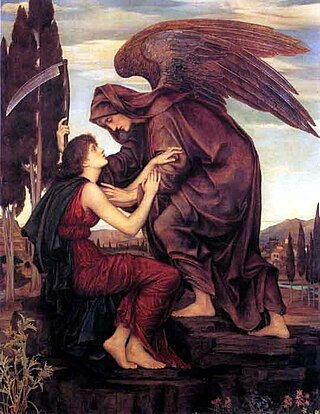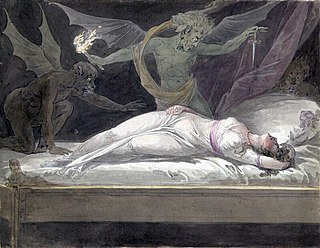
Lilith, also spelled Lilit, Lilitu, or Lilis, is a feminine figure in Mesopotamian and Jewish mythology, theorized to be the first wife of Adam and a primordial she-demon. Lilith is cited as having been "banished" from the Garden of Eden for not complying with and obeying Adam.

The Malleus Maleficarum, usually translated as the Hammer of Witches, is the best known treatise about witchcraft. It was written by the German Catholic clergyman Heinrich Kramer and first published in the German city of Speyer in 1486. Some describe it as the compendium of literature in demonology of the 15th century. Kramer presented his own views as the Roman Catholic Church's position.

Demonology is the study of demons within religious belief and myth. Depending on context, it can refer to studies within theology, religious doctrine, or occultism. In many faiths, it concerns the study of a hierarchy of demons. Demons may be nonhuman separable souls, or discarnate spirits which have never inhabited a body. A sharp distinction is often drawn between these two classes, notably by the Melanesians, several African groups, and others. The Islamic jinn, for example, are not reducible to modified human souls. At the same time these classes are frequently conceived as producing identical results, e.g. diseases.

Samael is an archangel in Talmudic and post-Talmudic tradition; a figure who is the accuser or adversary, seducer, and destroying angel.

Asmodeus or Ashmedai is a king of demons in the legends of Solomon and the constructing of Solomon's Temple.

Christian demonology is the study of demons from a Christian point of view. It is primarily based on the Bible, the interpretation of these scriptures, the writings of early Christianity philosophers, hermits, and the associated traditions and legends incorporated from other beliefs.

There have been various attempts at the classification of demons within the contexts of classical mythology, demonology, occultism, and Renaissance magic. These classifications may be for purposes of traditional medicine, exorcisms, ceremonial magic, witch-hunts, lessons in morality, folklore, religious ritual, or combinations thereof. Classifications might be according to astrological connections, elemental forms, noble titles, or parallels to the angelic hierarchy; or by association with particular sins, diseases, and other calamities; or by what angel or saint opposes them.

The gender attributed to demons has varied from one belief system to the next.

An incubus is a male demon in human form in folklore that seeks to have sexual intercourse with sleeping women; the corresponding spirit in female form is called a succubus. Parallels exist in many cultures.
In the Zohar, Lurianic Kabbalah, and Hermetic Qabalah, the qlippoth, are the representation of evil or impure spiritual forces in Jewish mysticism, the opposites of the Sefirot. The realm of evil is called Sitra Achra in Kabbalistic texts.
In European mythology and literature, a cambion is the offspring produced from a human–demon sexual union, typically involving an incubus or a succubus. In the word's earliest known uses, it was interchangeable with changeling.
Naamah or Nahemoth is a demon described in the Zohar, a foundational work of Jewish mysticism. She originated from and is often conflated with another Naamah, sister to Tubal-cain.
In Kabbalah, Eisheth Zenunim is a princess of the qlippoth who rules Gamaliel, the order of the qlippoth of Yesod. She is found in Zohar 1:5a as a feminine personification of sin.
Agrat bat Mahlat is a demon in Jewish mythology.

Ruby is a demon on The CW's Supernatural, portrayed mainly by actresses Katie Cassidy and Genevieve Cortese. Created by the writers to expand on the characterization of demons within the series, she first appears in the third season, wherein she assists series protagonists Sam and Dean Winchester in fighting her fellow demons. By the fourth season, she has won Sam's trust and begins training him to kill demons with his psychic powers, though Dean remains fearful of ulterior motives. The character is killed at the end of the fourth season. In the fifteenth season, Ruby returns through flashbacks and a visit to the Empty, the angels' and demons' afterlife.
In the teachings of Rabbi Isaac Luria, it is said that there are many Liliths. Manasseh Matlub Sithon said "many Liliths and demons are abroad, and go up and down."

Spectrophilia, also known as Phasmophilia, is sexual attraction to either ghosts or sexual arousal from images in mirrors, as well as the alleged phenomenon of sexual encounters between ghosts and humans.

Lilith, a biblical character suggested to be Adam's first wife and a significant female figure from Jewish mythology, has been developed over time into distinct characters in popular culture. One writer on witches, Judika Illes, wrote, "No spirit exerts more fascination over media and popular culture than Lilith. Her appearances are genuinely too numerous to count." Lilith is one of several figures with biblical or related origins integrated into popular culture who have been titled demon.










